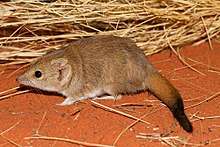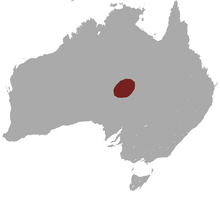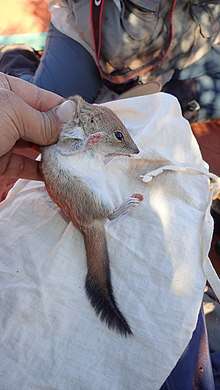Crest-tailed mulgara
The crest-tailed mulgara (Dasycercus cristicauda), is a small to medium-sized Australian carnivorous marsupial and a member of the family Dasyuridae (meaning "hairy tail")[1] which includes quolls, dunnarts, the numbat, Tasmanian devil and extinct thylacine. The crest-tailed mulgara is among a group of native predatory mammals or mesopredators endemic to arid Australia.[2]
| Crest-tailed mulgara | |
|---|---|
 | |
| Crest-tailed mulgara, Simpson Desert | |
| Scientific classification | |
| Kingdom: | Animalia |
| Phylum: | Chordata |
| Class: | Mammalia |
| Infraclass: | Marsupialia |
| Order: | Dasyuromorphia |
| Family: | Dasyuridae |
| Genus: | Dasycercus |
| Species: | D. cristicauda |
| Binomial name | |
| Dasycercus cristicauda (Krefft, 1867) | |
 | |
| Crest-tailed mulgara range | |

Description
The crest-tailed mulgara is a small to medium-sized mammal with sandy coloured fur on the upper parts leading to a darker grey on the under parts and inner limbs.[3] The species is strongly sexually dimorphic with adult males weighing 100 g to 185 g and females weighing 65 g to 120 g.[4] Head-body length of 125–230 mm and tail length is between 75–125 mm.[3][4] Identification between the two species within the genus Dasycercus has proven difficult with the crest-tailed mulgara (Dasycercus cristicauda) often confused with the brush-tailed mulgara or ampurta (D. blythi). Tail morphology is a primary identifying feature between the two species.[2] The crest-tailed mulgara has a crest of fine black hairs along the dorsal edge of the tail creating a fin-like crest and hair length tapering towards the tip. In contrast the brush-tailed mulgara tail hair is not crested, black hair starts half way along the upper surface of the tail and dorsal hair length remains consistent.[3] Nipple count also differs between the two species and is another distinguishing feature. The female crest-tailed mulgara has eight nipples compared to the brush-tailed mulgara who only has six.[2][3][5]
Taxonomy
There has been taxonomic confusion within the genus Dasycercus described by Peters in 1875.[3] Four named forms of carnivorous marsupials have been assigned to this genus.[3] Kreft,1867, first described Chaetocercus cristicauda in 1877.[3] A second form, Phascogale blythi was described by Waite, 1904, followed by a third form, Phascogale hillieri described by Thomas,1905.[3] Jones 1923, described two species of mulgara Dasycercus cristicauda and D. hillieri.[6] but decades on, William Ride’s 'A Guide to the Native Mammals of Australia' published in 1970 referred only to a single species, Dasycercus cristicauda, and in 1988 Mahoney and Ride placed all three species in the synonymy of D. cristicauda.[3] A fourth species, Dasyuroides byrnei, described by Spencer, 1896, was included by Mahoney and Ride however a lack of consensus resulted in its exclusion to the genus Dasycercus.[3] In 1995 Woolley described two sub-species, D. cristicauda cristicauda and D. cristicauda hillieri,[7] which were later confirmed to be two species using mitochondrial gene sequencing by Adams, Cooper and Armstrong in 2000. Woolley resolved the taxonomic and nomenclatural issues in 2005 and the species was re-named to two genetically distinct forms, D. cristicauda previously D. hillieri or the Ampurta and D. blythi previously named D. cristicauda or the Mulgara.[3]
Distribution
The crest-tailed mulgara inhabits areas of arid Australia. It has been recorded in the southern Simpson Desert near the tri-state border and in the Tirari and Strzelecki Deserts of South Australia and the western Lake Eyre region.[8] Historically the species’ geographic range was much larger incorporating areas from Ooldea on the eastern edge of the Nullarbor Plain and the Musgrave Ranges in South Australia, Sandringham Station in Queensland (last record in 1968)[9] and from the Canning Stock Route and near Rawlinna on the Nullarbor Plain in Western Australia.[8] Owl pellet examinations showed presence of crest-tailed mulgara near the southern and south-eastern margins of the Strzelecki dunefield/sandplain, in the Flinders Ranges and at Mutawintji National Park in far-western New South Wales.[10] Due to the levels of taxonomic uncertainty, misidentification may have led to an overestimated distribution especially when based on older records. This has created difficulties in assessing and interpreting temporal changes within its historic distribution.[11]
Ecology and Habitat
Habitat
The crest-tailed mulgara inhabits crests and slopes of sand ridges, or around salt lakes in inland Australia.[2][4] During the day it shelters in burrows which are located at the base of sandhill canegrass (Zygochloa paradoxa) clumps[2] or Nitre bush (Nitraria billardieri) growing around the edges of salt lakes.[4] Burrow site suitability, rainfall, food resources and the fire age of the vegetation community may be a factor influencing their distribution.[2]
Conservation Status
_closeup.jpg)
The following are the federal, state and international listings for the crest-tailed mulgara.[8] The mulgara was presumed extirpated in New South Wales for more than a century, but was re-discovered in 2017 in Sturt National Park north-west of Tibooburra.[13]
Federal Listing Status
Under the Environment Protection and Biodiversity Conservation Act 1999 (the EPBC Act): Listed as Vulnerable.
Non-statutory Listing Status
IUCN: Listed as Near Threatened (Global Status: IUCN Red List of Threatened Species).
WA: Listed as P4 (Priority Flora and Priority Fauna List (Western Australia)).
NGO: Listed as Near Threatened (The Action Plan for Australian Mammals 2012).
State Listing Status
NSW: Listed as Extinct (Biodiversity Conservation Act 2016), April 2018.
NT: Listed as Vulnerable (Territory Parks and Wildlife Conservation Act 2000), 2012.
QLD: Listed as Vulnerable (Nature Conservation Act 1992), September 2017.
SA: Listed as Endangered (National Parks and Wildlife Act 1972), June 2011.
Threats
The crest-tailed mulgara is sensitive to predation by the European red fox and feral cat,[2] changes to fire regimes together with environmental degradation and habitat homogenization attributed to grazing from livestock and introduced European rabbits.[10][14] During post-release of rabbit hemorrhagic disease virus (RHDV), the crest-tailed mulgara underwent a 70-fold increase in its extent of occurrence and a 20-fold increase in its area of occupancy.[15]
References
- "A mammalian lexicon". Biology of Mammals. 27 May 2018.
- Pavey, C. R., Nano, C. E. M., Cooper, S. J. B., Cole, J. R., & McDonald, P. J. (2012). Habitat use, population dynamics and species identification of mulgara, Dasycercus blythi and D. cristicauda, in a zone of sympatry in central Australia. Australian Journal of Zoology, 59(3), 156-169. doi:10.1071/ZO11052
- Woolley, P.A. (2005). The species of Dasycercus Peters, 1875 (Marsupialia: Dasyuridae). Memoirs of Museum Victoria, 62(2), 213–221.
- Van Dyck, Steve; Strahan, Ronald (2008). The mammals of Australia. Australia: New Holland Publishers. p. 50.
- Menkorst, P. & Knight, F. (2011). A field guide to the mammals of Australia. Melbourne, Victoria, Australia: Oxford. p. 52-53. ISBN 9780195573954.
- Jones, Frederic Wood (1923). The Mammals of South Australia. Part 1 The Monotremes and the Carnivorous Marsupials. Adelaide: Government Printer. pp. 102–109.
- Strahan, Ronald (1995). The Mammals of Australia. Chatswood: Reed Books. p. 56. ISBN 0-73010484-2.
- "Species Profile and Threats Database". Australian Government Department of Environment and Energy. 6 June 2018.
- Woolley, P.A. (1990). "Mulgara, Dasycercus cristicauda (Marsupialia: Dasyuridae: their burrows and records of attempts to collect live animals between 1966 and 1979". Australian Mammalogy. 13: 61–64.
- Letnic, M., Feit, A., Mills, C., & Feit, B. (2016). The crest-tailed mulgara (Dasycercus cristicauda) in the south-eastern Strzelecki Desert. Australian Mammalogy, 38(2), 241-245. doi:10.1071/AM15027
- Woinarski, J. & Burbidge, A.A. 2016. Dasycercus cristicauda. The IUCN Red List of Threatened Species 2016: e.T6266A21945813. http://dx.doi.org/10.2305/IUCN.UK.2016-1.RLTS.T6266A21945813.en. Downloaded on 05 June 2018
- Queale, L; Foulkes, J; Canty, P; Barratt (2000). "The diet of the Ampurta (Dasycercus hillieri) and the Kowari D. byrnei in north-eastern South Australia". Australian Mammal Society 2000 Conference Proceedings.
- z3517017 (2017-12-15). "Mammal long thought extinct in NSW resurfaces in state's west". UNSW Newsroom. Retrieved 2017-12-18.
- "Threatened Species of the Northern Territory" (PDF). Crest-tailed Mulgara (Dasycercus cristicauda).
- Pedler, R. D., Brandle, R., Read, J. L., Southgate, R., Bird, P., & Moseby, K. E. (2016). Rabbit biocontrol and landscape‐scale recovery of threatened desert mammals. Conservation Biology, 30(4), 774-782. doi:10.1111/cobi.12684
External links
| Wikimedia Commons has media related to Dasycercus cristicauda. |
